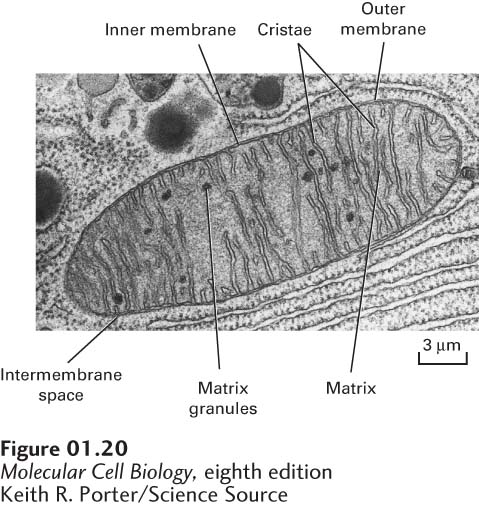Mitochondria Are the Principal Sites of ATP Production in Aerobic Cells

FIGURE 1-20 Electron micrograph of a mitochondrion in a pancreas cell. The smooth outer membrane forms the outside boundary of the mitochondrion. The inner membrane is distinct from the outer membrane and is highly invaginated to form sheets and tubes called cristae; ATP is produced by proteins embedded in the membranes of the cristae. The aqueous space between the inner and outer membranes (the intermembrane space) and the space inside the inner membrane (the matrix) each contain specific proteins important for the metabolism of sugars, lipids, and other molecules.
[Keith R. Porter/Science Source.]
Most eukaryotic cells contain many mitochondria (Figure 1-20), which occupy up to 25 percent of the volume of the cytoplasm. These complex organelles, which are the main sites of ATP production during aerobic metabolism, are generally exceeded in size only by the nucleus, vacuoles, and chloroplasts. The two membranes that bound a mitochondrion differ in composition and function. The outer mitochondrial membrane contains proteins that allow many molecules to move from the cytosol to the intermembrane space between the inner and outer membrane. The inner mitochondrial membrane, which is much less permeable, is about 20 percent lipid and 80 percent protein—a proportion of protein that is higher than those in other cellular membranes. The surface area of the inner membrane is greatly increased by a large number of infoldings, or cristae, that protrude into the matrix, or central aqueous space.
In non-photosynthetic cells, the principal fuels for ATP synthesis are fatty acids and glucose. The complete aerobic degradation of 1 molecule of glucose to carbon dioxide and water is coupled to the synthesis of as many as 30 molecules of ATP from ADP and inorganic phosphate (see Figure 1-6). In eukaryotic cells, the initial stages of glucose degradation take place in the cytosol, where 2 ATP molecules per glucose molecule are generated. The terminal stages of oxidation and ATP synthesis are carried out by enzymes in the mitochondrial matrix and inner membrane (see Chapter 12); as many as 28 ATP molecules per glucose molecule are generated in mitochondria. Similarly, virtually all the ATP formed in the oxidation of fatty acids to carbon dioxide is generated in mitochondria. Thus mitochondria can be regarded as the “power plants” of the cell.
Mitochondria contain small DNA molecules that encode a small number of mitochondrial proteins; the majority of mitochondrial proteins are encoded by nuclear DNA. As discussed in Chapter 12, the popular endosymbiont hypothesis postulates that mitochondria originated by endocytosis of an ancient bacterium by the precursor of a eukaryotic cell; the bacterial plasma membrane evolved to become the inner mitochondrial membrane.
